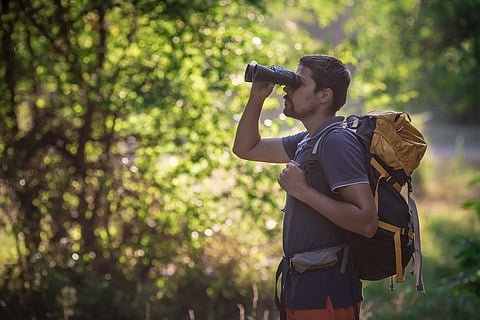
- Destinations
- Experiences
- Stay
- What's new
- Celebrating People
- Responsible Tourism
- CampaignsCampaigns
- Subscribe
- Buy Now

In October 2019, news reports discussed the first-ever Indian city to get a comprehensive bird atlas - thanks to volunteers. The Bird Atlas project of Mysuru, which has been running for three years, has documented 192 kinds of birds in the city, with 130 species sighted in the winter and 105 in the summer or monsoon. There are several such bird mapping projects around the country that you can sign up for as a volunteer, even when you are travelling on your next vacation. You may become a citizen scientist who maps birds. Spend time watching birds, taking notes, identifying, counting, and sharing your photos to help professionals better understand and conserve birds worldwide.
In 2020, the European Breeding Bird Atlas (Ebba2) revealed that Europe's breeding bird populations have shifted on average one kilometre north annually for the past three decades, likely driven by the climate crisis. This was one of the world's largest citizen science projects on biodiversity, and reports say that it provided the most detailed picture yet of the distribution of the continent's birds after 120,000 volunteers and fieldworkers surveyed 11m square kilometres from the Azores in the west to the Russian Urals in the east. The Bird Atlas outputs are used by policymakers in various countries and are excellent examples of citizen science in nature conservation. Here are some bird mapping projects you can participate in on your travels around the country.
This annual citizen science project records the diversity and abundance of bird species in the Himalayas every May. Around 350 birdwatchers from three Himalayan countries gathered in 2023 to document 625 species on 1,172 checklists. Participants came from 25 different states, union territories, provinces, and districts. In its first edition in 2022, about 607 species were recorded and in 2023 they recorded 654 species. Some bird enthusiasts also lead bird walks. Perhaps you could build a bird observation walk on your next trip to the Himalayas. Check for upcoming events here.
Every year, bird enthusiasts gather to document the unique or near-endemic birds of our subcontinent. The checklists that are compiled are included in the Global Big Day. You can map birds from anywhere in the country and record what you see and hear on eBird, a free, web-based tool for recording bird observations. Endemic Bird Day runs from midnight to midnight, giving you the opportunity to complete several checklists throughout the day and night. Incidentally, this day falls on the same day as Global Big Day, when birdwatchers from all over the world aim to document as many species as they can in a 24-hour period.
The Biodiversity Atlas-India provides a comprehensive natural history web platform for species-based bioinformatics. The vast repository of information is provided by citizen scientists, photographers, and professional scientists, and it is peer-reviewed and edited by advanced amateurs and professionals. It is one of India's most integrated professional-amateur groups in gathering vast amounts of data on Indian biodiversity in order to investigate ecological trends. One part is the project Birds of India, an internet-based and peer-reviewed resource devoted to Indian birds. Their website provides a popular platform for the Indian birder community to organise accessible information in a free and user-friendly style, to which they can also contribute in a variety of ways. For more information, check here.
